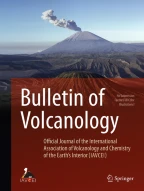Abstract
This paper documents a complex sequence of interbedded lapilli-fall, base-surge, and pyroclastic-flow deposits, here named the Monte Guardia sequence, that erupted from volcanic centers in the southern part of Lipari (Aeolian Island Arc). Radiocarbon data from ash-flow tuffs above and below this sequence bracket its eruption between 22,600 and 16,800 years ago. Geologic evidence, however, suggests that this single eruptive cycle had a more restricted duration of years to tens-of-years.
The basis for our interpretations comes from data measured at 38 detailed sections located throughout the island. The Monte Guardia sequence rests on a series of lower rhyolitic endogenous domes in the southern part of Lipari and it covers the oldest lavas, lahars, and pyroclastic flows in the north. Only in the northeast part of the island is it covered by younger deposits which there consist of lapilli tuffs and lavas of the Monte Pilato rhyolitic cycle. The deposit ranges in thickness from more than 60 m surrounding the vents in the south to less than a few decimeters at 10 km distance in the north. Throughout most of the island the Monte Guardia sequence overlies a thin andesitic lapilli-fall layer which is a key bed for correlation. This lapilli tuff probably erupted from a volcanic center on another island of the Aeolian Arc (possibly Salina).
The principal activity of the Monte Guardia sequence started with an explosion that formed a continuous breccia blanket covering most of the island. Some pumiceous blocks within this breccia are composed of alternating bands of acidic and andesitic composition suggesting that the initiation of pyroclastic activity could have been triggered by magma mixing. Typical Monte Guardia sequence consists of explosive products that grade from magmatic (pumice-fall) to phreatomagmatic (base-surge) character. The eruptive cycle is characterized by a number of energy decreasing megarhythms that start with a lapilli-fall bed and end with a base-surge set that progresses through sand-wave, massive, and planar beds. Isopach maps of the fall and surge deposits indicate that both types were directed to the northwest by prevailing winds. Existing topographic relief was an additional factor that affected the emplacement of surge products. At the end of the cycle andesitic pyroclastic flows and rhyolitic endogenous domes were emplaced above the Monte Guardia deposits near the vent.
Similar content being viewed by others
References
Bergeat, A., 1899,Die äolischen Inseln (Stromboli, Panaria, Salina, Lipari, Vulcano, Filicudi und Alicudi. Abh math. phys. Kl. kgl. bayer. Akad. Wiss.,20, I. Abt., p. 274, München.
Crisci, G. M., Delibrias, G., De Rosa, R., Lanzafame, G., Mazzuoli, R., Sheridan, M. F. andZuffa, G. G., 1981,Pyroclastic Deposit of the Monte Guardia Eruption Cycle on Lipari (Aeolian Arc, Italy) (Abs). Int. Assoc. Sedimentologists, 2nd Eur. Mtg., Bologna, p. 40–42.
Crowe, B. M. andFisher, R. V., 1973,Sedimentary Structures in Base-surge Deposits with Special References to Cross-bedding, Ubehebe Craters, Death Valley, California. Geol. Soc. America Bull.,84, p. 663–682.
Duffield, W. A., Bacon, C. R. andRoquemore, G. R., 1979,Origin of Reverse-graded Bedding in Air-fall Pumice, Coso Range, California. J. Volcanol. Geotherm. Res.,5, p. 35–48.
Fisher, R. V. andWaters, A. C., 1969,Bedforms in Base-surge Deposits: Lunar Implications. Science,165, p. 1349–1352.
—————, 1970,Base Surge Bedforms in Maar Volcanoes. Am. Jour. Sci.,268, p. 157–180.
Franzini, M., Leoni, L. andSaitta, M., 1975,Revisione di una metodologia analitica per fluorescenza X, basata sulla correzione completa degli effetti di matrice. Soc. Mineral. Italiana Rend.,31, p. 365–378.
Heiken, G., 1971,Tuff Rings: Examples from the Fort Rock-Christmas Lake Valley Basin, South-central Oregon. Jour. Geophys. Res.,76, p. 5615–5626.
Lorenz, V., 1974,Vesiculated Tuffs and Associated Features. Sedimentology,21, p. 273–291.
Pichler, H., 1976,Carta geologica dell’Isola di Lipari (scala 1:10.000). Firenze, Litografia Artistica Cartografica.
—————, 1980,The Island of Lipari. Soc. Mineral. Italiana Rend.,36, p. 415–440.
Ricci Lucchi, F., 1969,Recherches stratonomiques et sédimentologiques sur le flysch miocène de la Romagne (formation «marnoso-arenacea»). Gior. Geologia,35, p. 163–192.
Schmincke, H. U., Fisher, R. V. andWaters, A. C., 1973,Antidune and Chute and Pool Structures in the Base Surge Deposits of the Laacher See Area, Germany. Sedimentology,20, p. 553–574.
Self, S. andSparks, R. S. J., 1978,Characteristics of Widespread Pyroclastic Deposits Formed by the Interaction of Silicic Magma and Water. Bull. Volcanol.,41, p. 196–212.
Sheridan, M. F., 1979,Emplacement of Pyroclastic Flows. In:Chapin, C. E. andElston, W. E., eds.,Ash-flow Tuffs. Geol. Soc. America Special Paper,180, p. 125–136.
————— andUpdike, R. G., 1975,Sugarloaf Mountain Tephra — A Pleistocene Rhyolitic Deposit of Base-surge Origin in Northern Arizona. Geol. Soc. America Bull.,86, p. 571–581.
----- andWohletz, K. H., 1981,Hydromagmatic Volcanism: the Systematics of Water-pyroclast Equilibration. Science, in press.
Sparks, R. S. J., Sigurdsson, H. andWilson, L., 1977,Magma Mixing: a Mechanism for Triggering Acid Explosive Eruptions. Nature,267, p. 315–318.
————— andWalker, G. P. L., 1973,The Ground Surge Deposit: A Third Type of Pyroclastic Rock. Nature,241, p. 62–64.
Walker, G. P. L., 1973,Explosive Volcanic Eruptions. A New Classification Scheme. Geol. Rundschau.,62, p. 431–446.
Waters, A. C. andFisher, R. V., 1971,Base Surge and Their Deposits: Capelinhos and Taal Volcanoes. Jour. Geophys. Res.,76, p. 5596–5614.
Wohletz, K. H. andSheridan, M. F., 1979a, Explosive Hydromagmatic Activity (abstract). Symposium on Intraplate Volcanism. Hawaii.
————— and —————, 1979b,A Model of Pyroclastic Surge. In:Chapin, C. E. andElston, W. E., eds.,Ash-flow Tuffs. Geol. Soc. America Special Paper180, p. 77–194.
Author information
Authors and Affiliations
Additional information
Paper no. 487, P.F. Geodinamica, Subproject Volcanic Risk.
Rights and permissions
About this article
Cite this article
Crisci, G.M., De Rosa, R., Lanzafame, G. et al. Monte guardia sequence: a late-pleistocene eruptive cycle on Lipari (Italy). Bull Volcanol 44, 241–255 (1981). https://doi.org/10.1007/BF02600562
Received:
Revised:
Issue Date:
DOI: https://doi.org/10.1007/BF02600562
